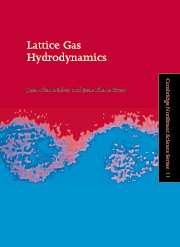Book contents
- Frontmatter
- Contents
- Preface
- Chapter 1 Basic ideas
- Chapter 2 Microdynamics: general formalism
- Chapter 3 Microdynamics: various examples
- Chapter 4 Equilibrium statistical mechanics
- Chapter 5 Macrodynamics: Chapman–Enskog method
- Chapter 6 Linearized hydrodynamics
- Chapter 7 Hydrodynamic fluctuations
- Chapter 8 Macrodynamics: projectors approach
- Chapter 9 Hydrodynamic regimes
- Chapter 10 Lattice gas simulations
- Chapter 11 Guide for further reading
- Appendix Mathematical details
- References
- Author index
- Subject index
Chapter 6 - Linearized hydrodynamics
Published online by Cambridge University Press: 13 October 2009
- Frontmatter
- Contents
- Preface
- Chapter 1 Basic ideas
- Chapter 2 Microdynamics: general formalism
- Chapter 3 Microdynamics: various examples
- Chapter 4 Equilibrium statistical mechanics
- Chapter 5 Macrodynamics: Chapman–Enskog method
- Chapter 6 Linearized hydrodynamics
- Chapter 7 Hydrodynamic fluctuations
- Chapter 8 Macrodynamics: projectors approach
- Chapter 9 Hydrodynamic regimes
- Chapter 10 Lattice gas simulations
- Chapter 11 Guide for further reading
- Appendix Mathematical details
- References
- Author index
- Subject index
Summary
As LGAs are constructed as model systems where point particles undergo displacements in discrete time steps and where configurational transitions on the lattice nodes represent collisional processes, one can view the lattice gas as a discretized version of a hard sphere gas on a regular lattice where particles are subject to an exclusion principle instead of an excluded volume. The advantage with LGAs is that, starting from exact microdynamical equations, statistical mechanical computations can be conducted rather straightforwardly in a logical fashion with well controlled assumptions to bypass the many-body problem. This is well exemplified by the development in Chapter 4 leading to the lattice Boltzmann equation. For the moment we shall consider the lattice gas automaton as a bona fide statistical mechanical model with extremely simplified dynamics. Nevertheless we may argue that the lattice gas exhibits two important features:
(i) it possesses a large number of degrees of freedom;
(ii) its Boolean microscopic nature combined with stochastic microdynamics results in intrinsic fluctuations.
Because of these spontaneous fluctuations and of its large number of degrees of freedom, the lattice gas can be considered as a ‘reservoir of thermal excitations’ in much the same way as a real fluid. Now the question must be raised – as for the hard sphere model in usual statistical mechanics – as to the validity of the lattice gas automaton to represent actual fluids. In Chapters 5 and 8 we consider full hydrodynamics and macroscopic phenomena.
Information
- Type
- Chapter
- Information
- Lattice Gas Hydrodynamics , pp. 137 - 152Publisher: Cambridge University PressPrint publication year: 2001
